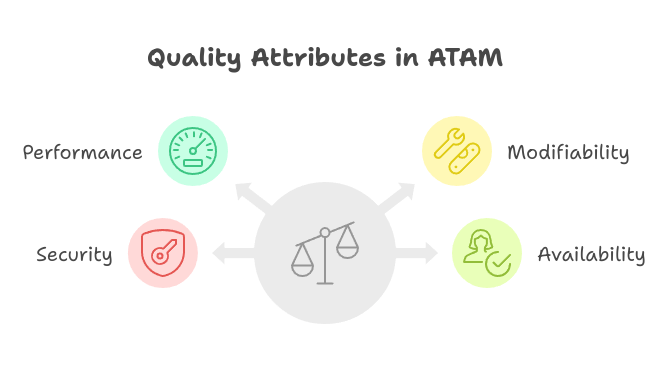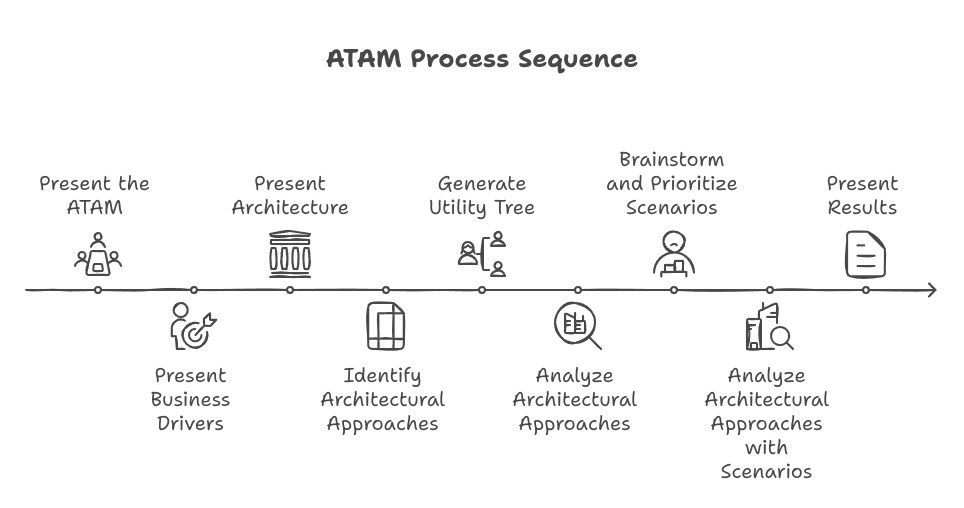In the complex world of software development, the architecture of a system plays a pivotal role in determining its success or failure. As systems grow in complexity, the need for a structured approach to evaluate architectural decisions becomes imperative. This is where the Architecture Tradeoff Analysis Method (ATAM) comes into play. Developed by the Software Engineering Institute (SEI) at Carnegie Mellon University, ATAM is designed to assess the consequences of architectural decisions in light of quality attribute requirements.
What is ATAM?
ATAM stands for Architecture Tradeoff Analysis Method. It is a systematic approach used to evaluate software architectures, focusing on how well they meet quality attributes such as performance, modifiability, security, and availability. The primary goal of ATAM is to identify and assess architectural risks before they become costly issues.
Key Concepts of ATAM
1. Quality Attributes
Quality attributes are non-functional requirements that define system behavior. Examples include:
- Performance: Response time, throughput.
- Modifiability: Ease of change, adaptability.
- Security: Protection against unauthorized access.
- Availability: System uptime and fault tolerance.

2. Scenarios
Scenarios are used to capture and communicate quality attribute requirements. They are categorized as:
- Use Case Scenarios: Describe typical uses of the system.
- Growth Scenarios: Anticipate future changes.
- Exploratory Scenarios: Stress the system to uncover potential weaknesses.
3. Utility Tree
A utility tree helps prioritize quality attributes by breaking them down into scenarios, assigning importance, and assessing risks. This structured approach ensures that the evaluation focuses on the most critical aspects of the architecture.
4. Sensitivity Points and Tradeoffs
- Sensitivity Points: Architectural decisions that have a significant impact on quality attributes.
- Tradeoff Points: Situations where improving one quality attribute negatively affects another.
The ATAM Process
ATAM involves a nine-step process divided into two main phases:
Phase 1: Preparation and Initial Analysis
- Present the ATAM: Introduce the method and its goals to stakeholders.
- Present Business Drivers: Understand business goals and primary drivers.
- Present Architecture: Review the architecture in relation to business goals.
- Identify Architectural Approaches: Document the architectural patterns used.
- Generate Utility Tree: Identify and prioritize quality attributes.
- Analyze Architectural Approaches: Evaluate approaches against prioritized attributes.
Phase 2: Detailed Analysis and Reporting
- Brainstorm and Prioritize Scenarios: Collect and rank scenarios from stakeholders.
- Analyze Architectural Approaches with Scenarios: Use scenarios as test cases for analysis.
- Present Results: Document findings, including risks, sensitivity points, and tradeoffs.

Real-World Examples
Avionics Systems
The U.S. Army’s Technology Applications Program Office (TAPO) used ATAM to evaluate the software architecture for a product line of avionics systems. This assessment identified architectural risks and provided recommendations to enhance system modifiability and performance.
The application of ATAM helped in improving the system’s performance and adaptability, ensuring it met the required quality attributes.
Wargame Simulation Systems:
ATAM was applied to a major wargaming simulation system to uncover risks related to performance and scalability. The evaluation guided architectural improvements to better meet quality attribute requirements.
The use of ATAM led to significant improvements in the system’s performance and scalability, aligning with the organization’s business goals.
Common Avionics Architecture System (CAAS)
A case study on CAAS demonstrated how ATAM facilitated the creation of a scalable system for multiple helicopter cockpits. The method addressed modernization challenges and reduced the cost of ownership through a common avionics architecture.
ATAM helped in developing a scalable and cost-effective system that met the quality attribute requirements for multiple helicopter cockpits.
These examples illustrate ATAM’s practical application in evaluating and improving software architectures across various domains.
Benefits of ATAM
- Early Risk Identification: Mitigates risks before significant investment.
- Improved Stakeholder Communication: Enhances understanding of system requirements.
- Better Architectural Decisions: Informed decisions lead to robust systems.
Comparison with Other Methods
1. Software Architecture Analysis Method (SAAM)
- Purpose: SAAM is primarily focused on evaluating the modifiability of software architectures using scenarios and metrics. It is simpler and less specialized in trade-off analysis compared to ATAM.
- Key Differences: While SAAM focuses on modifiability, ATAM assesses multiple quality attributes and their trade-offs, making it more comprehensive.
2. Cost-Benefit Analysis Method (CBAM)
- Purpose: CBAM is an extension of ATAM that incorporates economic models and quantitative measures to evaluate architectural decisions.
- Key Differences: CBAM adds a financial perspective to the trade-off analysis, allowing for more detailed cost-benefit assessments compared to ATAM alone.
3. Software Architecture Comparison Analysis Method (SACAM)
- Purpose: SACAM is used to compare different software architectures based on business goals and quality attributes.
- Key Differences: SACAM focuses on comparing architectures rather than evaluating a single architecture’s trade-offs, as in ATAM.
4. Active Reviews for Intermediate Designs (ARID)
- Purpose: ARID combines peer reviews and scenario-based evaluation to assess intermediate design decisions.
- Key Differences: ARID emphasizes peer review and iterative feedback, whereas ATAM focuses on structured analysis of quality attributes and trade-offs.
5. Architecture-Level Modifiability Analysis (ALMA)
- Purpose: ALMA uses static and dynamic analysis techniques to measure and compare the modifiability of architectures.
- Key Differences: ALMA is more specialized in modifiability analysis, whereas ATAM covers a broader range of quality attributes.
Tools Supporting Architecture Trade-off Analysis
- ArchiMate: A modeling language for representing and evaluating quality attributes and trade-offs.
- ArchStudio: An integrated development environment for system architectures.
- SAAT: Implements the ATAM framework to conduct and document the process.
In summary, while other methods like SAAM and SACAM focus on specific aspects of architecture evaluation, ATAM provides a comprehensive approach to assessing multiple quality attributes and their trade-offs. CBAM extends ATAM by incorporating economic analysis, making it suitable for cost-sensitive decisions.
Conclusion
ATAM is a valuable method for evaluating software architectures, ensuring that quality attributes are met while balancing tradeoffs. By integrating ATAM into the software development lifecycle, organizations can build resilient and efficient systems that align with business goals. That is also part of CPSA-F Certification.

